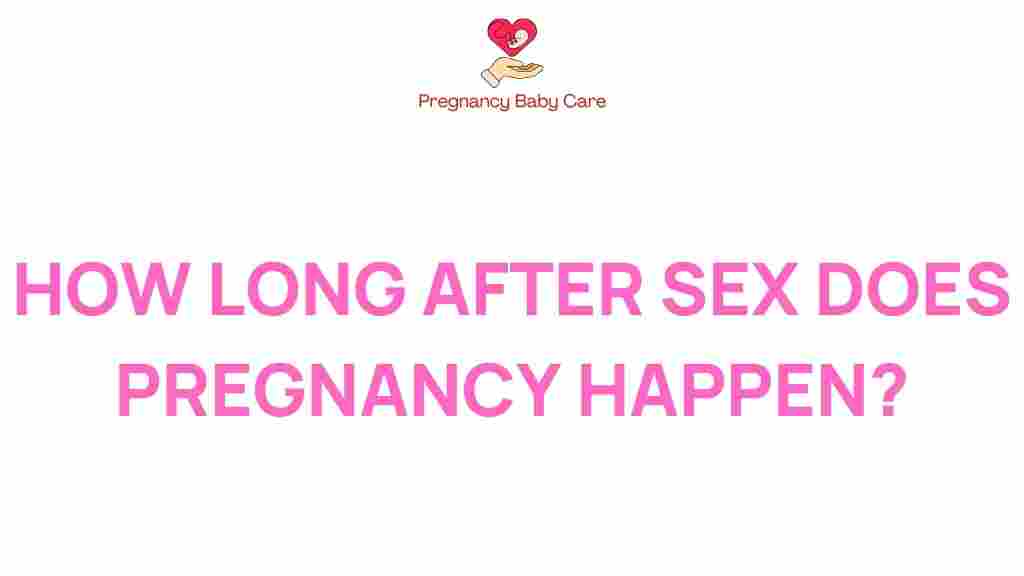The Intriguing Timeline: How Soon Can Pregnancy Occur After Sex?
Understanding the pregnancy timeline is crucial for anyone interested in reproductive health. Many people wonder how soon pregnancy can occur after sex, and this article will detail the intricate process of conception, ovulation, and fertility. We’ll dive deep into the factors that influence when pregnancy can happen, the lifespan of sperm, and how the menstrual cycle plays a role in this process. Let’s explore this fascinating topic together!
1. The Basics of Conception and the Menstrual Cycle
To grasp how soon pregnancy can occur after sex, it’s essential to understand the menstrual cycle and the events leading to conception.
- Menstrual Cycle Overview: Typically lasts 28 days, but can range from 21 to 35 days.
- Ovulation: The release of an egg occurs around the midpoint of the menstrual cycle, usually between days 12 to 16.
- Fertilization Window: This is the critical period when conception can occur, generally within 24 hours after ovulation.
2. The Role of Ovulation in the Pregnancy Timeline
Ovulation is a pivotal moment in the pregnancy timeline. During this phase, a mature egg is released from the ovary and travels down the fallopian tube. Here’s how it relates to pregnancy:
- If sperm are present in the fallopian tube when the egg is released, fertilization can occur.
- The egg has a lifespan of about 12 to 24 hours, making timing essential for conception.
- Sperm can survive in the female reproductive tract for up to 5 days, which means having sex before ovulation can lead to pregnancy as well.
3. The Sperm Lifespan and Its Importance
The lifespan of sperm plays a significant role in determining how soon pregnancy can occur after sex. Understanding this can help couples plan accordingly:
- Sperm Lifespan: Sperm can live in the female reproductive system for about 3 to 5 days under optimal conditions.
- Fertility Window: This means that having sex within 5 days leading up to ovulation can result in pregnancy.
4. Pregnancy Timeline After Sex: A Step-by-Step Process
Let’s break down the stages from sexual intercourse to the potential onset of pregnancy:
- Sexual Intercourse: Sperm are deposited in the vagina.
- Sperm Migration: Sperm swim through the cervix and into the uterus, reaching the fallopian tubes.
- Fertilization: If an egg is present (released during ovulation), fertilization occurs, typically within 12-24 hours.
- Implantation: The fertilized egg (now called a zygote) travels to the uterus and implants itself into the uterine lining, usually about 6-10 days after fertilization.
- Pregnancy Confirmation: Pregnancy hormones (hCG) can be detected in urine or blood tests about 10 days after conception.
5. Troubleshooting and Considerations
While the biological processes are generally straightforward, several factors can influence the timeline and the likelihood of conception:
- Irregular Menstrual Cycles: Women with irregular cycles may find it challenging to predict ovulation accurately.
- Age: Female fertility declines with age, particularly after age 35.
- Health Conditions: Conditions like polycystic ovary syndrome (PCOS) or endometriosis can affect ovulation.
- Stress and Lifestyle: Factors such as stress, diet, and exercise can impact the menstrual cycle and fertility.
If you’re struggling with conception, it may be useful to consult a healthcare provider or a fertility specialist to discuss your situation and options.
6. Sex Education and Reproductive Health
Understanding how pregnancy occurs is a vital aspect of sex education and reproductive health. Knowledge empowers individuals to make informed decisions regarding their sexual health and family planning. Here are some key points to consider:
- Comprehensive Sex Education: Effective programs teach about the menstrual cycle, ovulation, sperm lifespan, and the biology of conception.
- Contraceptive Options: Understanding how various contraceptives work can help individuals prevent unwanted pregnancies.
- Fertility Awareness: Learning to track ovulation can increase the chances of conception for those trying to conceive.
For more information, consider visiting resources like Planned Parenthood that provide access to sexual health education.
7. Conclusion
In summary, the journey from sexual intercourse to pregnancy involves a detailed pregnancy timeline that hinges on ovulation, sperm lifespan, and individual reproductive health. Understanding this process can help individuals and couples make informed choices about family planning and fertility. Whether you’re trying to conceive or prevent pregnancy, being aware of your body’s rhythms and cycles is essential.
For those looking to explore this topic further, check out our article on understanding ovulation and fertility for more insights.
Remember, if you have any concerns about your reproductive health or fertility, consulting a healthcare provider is always a wise step.
This article is in the category Pregnancy and created by PregnancyBabyCare Team
